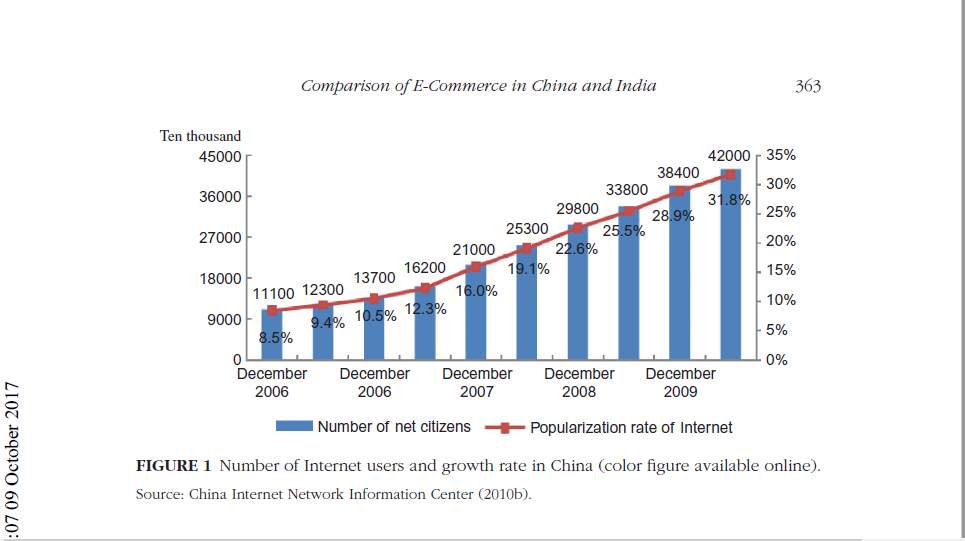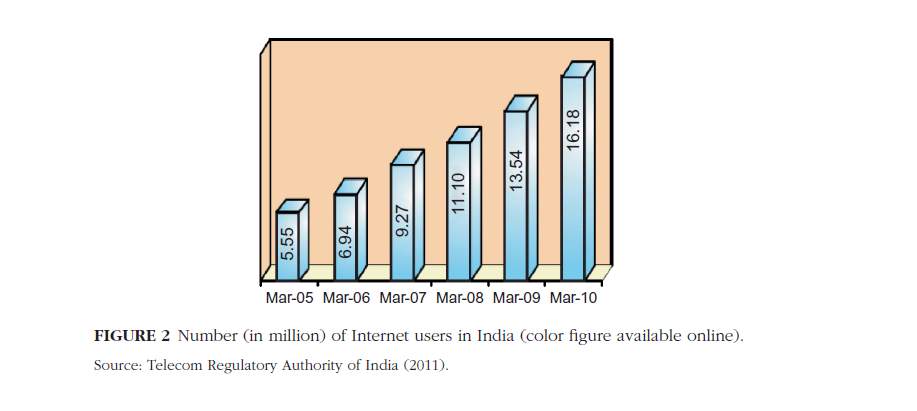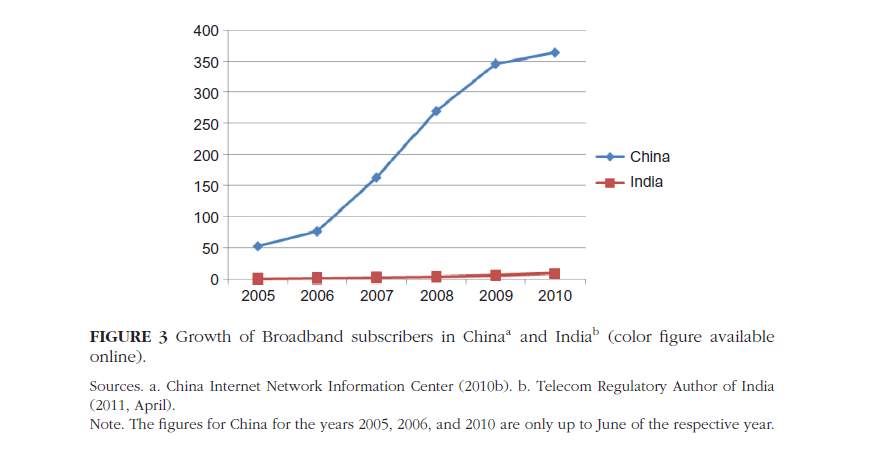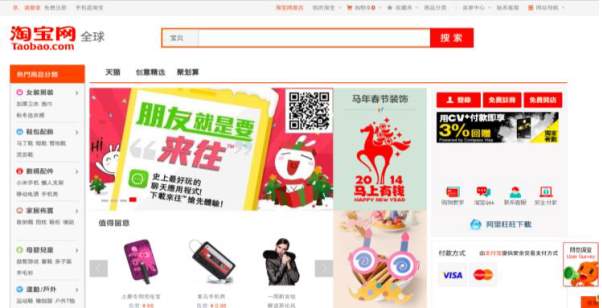Comparison of Domestic E-commerce Market in India and China
Info: 4734 words (19 pages) Dissertation
Published: 10th Dec 2019
Tagged: International BusinessE-commerce
Comparison of Domestic E-commerce Market in India and China- Case of Flipkart and Alibaba
Introduction
E-commerce is the use of electronic platform for buying, selling, transfer, or exchange of goods and serviceAlyoubi (2015). Concisely, E-commerce has brought revolution in the shopping habits of customers and has simultaneously changed the way of doing business. With the widespread use of Internet everything has come at one place “at the click of a button” we can shop around the world. The e-commerce has become the buzzword and has proved to be valuable for customer as well as businesses. E-commerce is available 24*7 through website to shop for goods and services and add them to their cart and make payments using debit card, credit card, internet banking, or cash on delivery and products are delivered at their doorsteps within a stipulated time span (Mishra & Kotkar, 2015). (Kumar & Khosla, 2017) Ecommerce has been categorised as B2B (Business to Business), B2C (Business to Consumer), C2C (Consumer to Consumer), C2B (Consumer to Business), B2G (Business to Government).
Developing countries has a huge potential for e-commerce. (Jeyashoke, Vongterapak, & Long, 2014) stated that online shopping has grown rapidly in China and India, two Asian giants which are ranked first and second respectively. These two economies have fast growing gross domestic product (GDP) and most populated countries in the world. Domestic e-commerce companies like Alibaba and Flipkart has gain momentum in their sales targeting urban consumers. However, there is still vast rural population which signifies an untapped market to work on. Alibaba is a Chinese e-commerce firm founded by Jack Ma in 1999 runs a C2C and B2C marketplace (Qing, 2008). Flipkart is an Indian e-commerce company based founded by Sachin and Binni Bansal in 2007 (Fatima, 2014).
The goal of this paper is to compare and analyse the domestic e-commerce market namely, Flipkart and Alibaba in developing or emerging economies like India and China. Challenges of e-commerce in developing countries is also mandatory in-order-to analyse their growth patterns in specific country. I will study the organizational background of Alibaba and Flipkart to frame my comparison of domestic e-commerce industry. I will study the cultural dimensions of online retail stores in India and China which would be another aspect of my study.
Literature Review
As stated byRay (2011) “As a symbol of globalization, e-commerce represents the cutting edge of success in this digital age and it has changed and is still changing the way business is conducted around the world.” The number of internet user climb sharply in developing countries. Developing countries namely, India and China have some common features large population, increasing middle class, high growth rates, and increasing foreign direct investment (FDI) Eisenberg and Gupta (2015). India being a democratic government Prime Minister Narinder Modi has initiated Digital India and compassionate towards foreign direct investment. China is the largest emerging market in the world and e-commerce has grown rapidly.
Alyoubi (2015) in his paper “E-commerce in Developing Countries and how to Develop them during the Introduction of Modern Systems”, presents a comprehensive definiton of e-commerce. The paper enlights the the case of developing countries and barriers to growth of e-commerce in developing countries. Kumar and Khosla (2017)also elobrates the different e-commerce models i.e B2B, B2C, B2G, C2C, and C2B and “Growth of E-Commerce in India”.
Hawk (2004)give a broad outlook of “A Comparison of B2C E-Commerce in Developing Countries”. The paper identifies the challenges of e-commerce in developing countries such as lack of telecommunications infrastructure, cultural barriers, logistics barriers, lack of trust among consumers, lack of awareness among consumers, low average income population, lack of legal and regulatory system. Bansal (2011) traces the internet development in “Growth of the Electronic Commerce in China and India: A Comparative Study” and identifying factors acting as barriers and driving forces. Internet connectivity started first in India than China but China is far in advance because of expansion of internet infrastructure.
Jeyashoke et al. (2014) has stated in this paper “Does Culture Matter? A Case Study on Online Retailing Stores across Three Asian Countries.”Hofstede’s dimensional model of natural culture to study in depth the difference in online stores and we would focus on four most appropriate dimensions to consumer behaviour namely individualism-collectivism (IDV), power distance (PDI), masculinity-femininity (MAS), and uncertainty avoidance (UAI).
Individual-collectivism magnitudes the relationship among individuals. It represents the way in which individual associate them themselves self-directed or collectively. While being individual they are least effected by other people but are driven by their personal preferences and needs. Whilst in collectivism they act as a part of a group and follow the obligations imposed by group. Green, Deschamps, and Paez (2005) mentioned in his paper that level of individual-collectivism varies within each country. The individual-collectivism does impacts the consumer buying patterns, as in individual would prefer buying products alone and would make decision based on his past experience and own preference however in collectivism people shop in groups and their decisions relies on family or friend’s perspective of brand. Individual shop for more new designs in the market while in collectivism they shop for brand and status products.
Power Distances means variations among masses should be lessened and interdependence exists between more influential and less influential people (Jeyashoke et al., 2014).Generally in family everyone is treated equally. People respect buying decision of superiors in large power distance culture while in small power distance people are free to make decisions. The choice of brands is their own decisions.
Jeyashoke et al. (2014) states that Uncertainty Avoidance means the degree to which people feel frightened by uncertainty and try to evade such situations. In high uncertainty avoidance culture people are more worried about their security and tend to sidestep risk as much possible as they can while in weak uncertainty avoidance culture people thoughtful of risks in their day to day life and assume it to be vital part of victory. In high uncertainty avoidance culture people need more rules and regulation to live life whereas in weak uncertainty avoidance culture people are more open-minded and happier to have less rules. Consumers from weak uncertainty avoidance are open, dynamic, innovative and entrepreneurial while high uncertainty avoidance consumers resist change and don’t accept new products and are more dependable on brand products to avoid risk.
In masculine culture people are more competitive and value status and money where as in feminine cultures people tend to be free and value spending time in alliance (Jeyashoke et al., 2014). Role of men and women is a significant point to consider as in masculine culture husband have decision making power in investments and living and wives are accountable for household decision for instance family purchasing while in feminine culture husbands would perform household duties like shopping same as wives.
China- Specific Challenges for E-commerce
China is a fastest growing economy with 1.3 billion population and one child policy strictly imposed by government to control the population but at the same time it has world best transportation and telecommunication networks within its major cities (Martinsons, 2008). China’s mobile phone users surpassed mobile users in United States in 2001 making it largest mobile communication market in the world (Tan & Ouyang, 2004). As telecommunication services are increasing and becoming affordable by large masses which is encouraging people to use internet on regular basis to e-commerce is trusting.
As internet access increases delivery concerns are major challenge for e-commerce. Heavy regulation are there on postal services and transport by rail and water (Martinsons, 2008).
Chinese firms faces serious obstacles like absence of legal laws, and security issues however, banking sector also has privacy issue and security concern related to credit card use (Tan & Ouyang, 2004). It means that Chinese firms are at risk because of the absence of policy and legal protection. Though Chinese banks has issued many debit card and credit card by 2007 still consumers prefer cash-on-delivery and post office transfer while shopping online from e-commerce website to make payments (Martinsons, 2008). This means China lacks in financial services as cash is used to make payments and use of debit cards and credit cards are just limited to some stores or locations only.
Business-to-Consumer (B2C) e-commerce in China was initially legitimized and the process to get government approval for stating up online project in China is a rigorous task (Martinsons, 2008). Online Ventures need to convince government that by setting up this business it would be advantageous to both economy as well as society. B2C e-commerce websites are created by entrepreneurs with domestic and foreign venture capital (Tan & Ouyang, 2004). In china banking industry is state owned and lend loans to state owned business as compared to private firms (Martinsons, 2008). Electronic payment infrastructure in China are not supporting e-commerce. Thus, building relationship with local banks is an important task for online business firms in China to allow credit card payments, cash-on-delivery, bank transfer and postal payments. Consumers prefer buying small products and make payments for the same through debit or credit cards and shop heavy products preferring cash-on-delivery (Martinsons, 2008).
India -Specific Challenges for E-commerce
The e-commerce was introduced in mid-1990s in India and the challenges it faced at the beginning were weak electronic payment infrastructure, lack of internet infrastructure and lack of awareness in customers (Mishra & Kotkar, 2015). It gained momentum in mid-2000 offering online services in travel services to customers which holds a most important share in e-commerce (Mishra & Kotkar, 2015).
The development of e-commerce in India has been an uphill task and faced numerous challenges such as inadequate infrastructure, logistics barriers, and lack of tax standardization (Kumar & Khosla, 2017). Delivering products, safe and secure to right consumers and at right time is the difficult job. Postal services in India are not worthwhile to rely upon and courier companies charge a huge amount for their services. E-commerce firms must get high valued products insured against the loss of theft. The tax structure in Indian economy is very confusing as there are numerous taxes imposed on goods and services which varies from state to state such Octroi charges, State entry tax, Value Added Tax (VAT) and recently imposed GST in economy by Narinder Modi.
Limited internet access and telecommunication infrastructure is another obstacle for e-commerce growth. It rates unwell on Internet Infrastructure and ranks in bottom in comparison of 57 countries (Fatima, 2014). Absence of security and confidential information are not secured online which hinders the e-commerce growth. Cyber Crime in e-commerce if also another challenge for credit card users in India (Kumar & Khosla, 2017). In order to make process of e-commerce safe and reliable government has passed Information and Technology Act.
India has poor distribution channel; rural and urban customers are provided with payment options as advance payment and cash-on-delivery respectively (Fatima, 2014). Customers are not sure enough to receive the products same as ordered if payment is done in advance. Consumers lack digital awareness and thus are not educated on using Internet as shopping platform. High cost of internet access is another stepping stone.
Bansal (2011) in her paper describes the number of users and broadband subscribers in India and China has increased in past five years. Government in developing countries understand the position of immediate use of ICT in economic growth, and had therefore have taken action to subscribe broadband connections.
Figure 1 shows the number of Internet users in China (Bansal, 2011).

Figure 1. Number of Internet users in China
Figure 2 represents the number of Internet users in India (Bansal, 2011).

Figure 2. Number of Internet users in India
Figure 3 shows the growth of Broadband subscribers in China and India (Bansal, 2011)

Figure 3. Growth of Broadband subscribers in China and India
Organizational Background of Alibaba
Alibaba.com is a member of the Alibaba Group of companies and runs both internationally and domestically in china with registered users of around 30 million together from 240 countries and 62 million registered users only from China (Qing, 2008). Alibaba has become global e-business leader and initially started with B2B services for small and medium size enterprises (SMEs) including 5 different companies namely Alibaba.com, Taobao, Alipay, China Yahoo (Huang, Hu, & Lu, 2009). Its18 founders established Alibaba group, led by Jack Ma, an English literature teacher. Jack Ma’s vision is to build e-commerce ecosystem which permits consumers as well as businesses to do business online (Qing, 2008). Taobao is a computer constructed instant messaging tool that enables text, video communication, and audio among sellers and buyers. Alipay is the third-party online payment platform with no transaction fees.
Organizational Background of Flipkart
Flipkart was founded by two computer-engineering students, Sachin Bansal and Binny Bansal passed out of Indian Institute of Technology (IIT) Delhi who were also ex-employees of Amazon.com (Mishra & Kotkar, 2015). Initially Flipkart started selling books online and slowly expanded in selling products like electronics, fashion and clothing, home decoration etc (Jeyashoke et al., 2014). Currently, Flipkart is India’s largest e-commerce company due to powerful networking and strong customer relationship and also sells its goods and service through a company named WS Retail (Mishra & Kotkar, 2015).
Flipkart introduced “Cash-on-Delivery” which permits customers to make payment at the time of delivery of product (Jeyashoke et al., 2014). Flipkart also provides other payment methods such as net banking, debit/credit card transactions, e-gift voucher and card swipe on delivery (Mishra & Kotkar, 2015). These payment methods were introduced as online shopping was a new perception in India and to customers either don’t have credit /debit cards or were scared due to security issues. Flipkart provides 30-day return policy to its customers in case the product is damaged or not same as described.
Comparative Study of Flipkart.com With Alibaba.com
Jeyashoke et al. (2014) mentions in his paper that Culture and economy patterns are chief drivers of e-commerce growth as shown in Table 1 below

Table 1. Culture indices of Indian, Chinese, and Thai. Source: (Jeyashoke et al., 2014)
Alibaba.com: online shopping website in China
The number of internet users in China has increased ten percent and reached 242 million in 2013 which makes China the biggest online shopping market (Jeyashoke et al., 2014).

Figure 4. Alibaba.com webpage
Alibaba.com is an international marketplace (www.alibaba.com) concentrating global consumers and a Chinese marketplace (www.alibaba.com.cn) concentrating china’s domestic consumers. In China, Alibaba.com targets C2C and B2C marketplace (www.taobao.com) e-commerce models.

Figure 5. Taobao.com webpage
Taobao (www.taobao.com) is one the biggest auction site in China and was founded in 2003 by Alibaba Group Holding Limited. Initially it followed a “free of charged” strategy which means there was no listing fee and transaction fee for a time span of 3 years to attract sellers and buyers (Jeyashoke et al., 2014). To strengthen the smooth transactions Taobao has introduced payment function known as “Zhifubao (Alipay) which transfer payments to sellers after the products are delivered to buyer (Jeyashoke et al., 2014). This payment method is beneficial to both sellers and buyers.
Taobao has developed complete ranking structure in which buyers and sellers rate themselves to ensure sellers have quality products and estimate if buyers are good consumers. The ranking data of each seller and buyer determined by period of using website and the number of transactions etc.
Flipkart.com: online shopping website in India
The number of internet users in India has increased over the years. Flipkart sells products through its own warehouse named WS Retail. Eisenberg and Gupta (2015) states that Flipkart has set up its warehouse in different states of India namely, Delhi, Tamil Nadu, Andhra Pradesh, Maharashtra, West Bengal, Karnataka with an ideal exposure of Indian consumers. Flipkart offers wide range of payment options to its consumers including debit card, credit card, cash-on-delivery (COD), online banking, and Easy monthly instalment (EMI). Customers can avail the benefit of easy monthly instalment to pick three, six, or twelve months’ time span to make the payment of heavy products as middle-income class of consumers are more in India.

Figure 6. Flipkart.com webpage
Flipkart has also introduced PayZippy to facilitate faster, secure and smoother payment system in e-commerce. Exchange policy of Flipkart is another remarkable feature which permits customers to return defected products within 30-days. Flipkart uses social marketing tools such as Facebook and Twitter to grab its customers. Understanding the lack of internet infrastructure Flipkart has user friendly website which runs at a lower speed of internet too.
Table 2 shows a summary of Indian and Chinese e-commerce portal showing main products, payment method, communication tool and other features as discussed above (Jeyashoke et al., 2014).

Table 2. Summary of the key features Source: (Jeyashoke et al., 2014).
Analysis
Effect of collectivism on online customer behaviour
Consumer buying decisions are inspired by status in scoiety and family benefits. Trust is the buiding block on the basis of which consumers take buying decisions. People following collectivism choose branded products to minimise risk.
Comparing the two countries India and China, India has scored maximum individualism culture which is nearly 50 as compared to China which scored just 16. This depicts that India has individualistic society structure than China.
Effect of power distance on online customer behaviour
As shown in Table 1 China scored 74 which is highest as comared to India which scored 71. High power distance in two countries represents inequality among its masses. In India caste system has a great influence o n its culture and follows a ranked setup. China follows Confucianism where people reverence their seniors in family and trust branded products.
Online shopping has brought change in the shopping method of customers living in both rural area with limited variety of products and urban areas with limited time for shopping. Flipkart understands the change in tend of shopping in rural ares and caters to their demand by offering a lower version of website which work well with lower speed of internet. Taobao also developed ranking structure for its buyers and sellers providing a platform with transperancy.
Effect of uncertainity avoidance on online customer behaviour
Table 1 shows that India scored more than China i.e 31 and 21 respectively in uncertainity avoidance. It represents that buiding trust has been the focus for both Taobao and Flipkat in Chinese and Indian market. Taobao presented Alipay and Flipkart provided PayZippy to ensure customers that there payments are secure and make their shopping experience contented.
Effect of masculinity-femininity on online customer behaviour
India and China both has masculinity culture in their economies. Male and female play distinct role in shopping. Womens have more concern in household shopping in both India and China.
Table 3 summarizes the effects of four cultural dimensions on e-commerce portal of India and China.

Table 3. Summary of the effects of four culture dimensions on online retail stores. Source: (Jeyashoke et al., 2014)
Conclusion
China and India are the large emerging markets which share many things in common like most of its population living in rural areas, illiterate people and poverty. Still large number of middle-income people have been growing in both India and China serving as a fuel to lead the developmental path of growth in e-commerce in two emerging economies. Due to the size of population these two countries are now observed as gigantic consumer marketplaces. However, there are numerous barriers to the growth of e-commerce such as internet infrastructure, lack of electronic payment structure, lack of legal and regulatory policies against theft. The government of both the countries has stepped forward to overcome these barriers and shown growth over the past few years which represents that e-commerce in China and India will experience growth in future.
I have taken initiatives to study-in-depth what this e-commerce is all about and what are the e-commerce model in relation to developing countries like India and China. I studied the challenges faced by Indian and Chinese e-commerce industry. I tried to made comparison of two domestic e-commerce portal Alibaba and Flipkart which are large e-commerce giants in their respective countries.
I studied the four culture dimensions namely Individualism-Collectivism (IDV), Power Distance (PDI), Uncertainty Avoidance (UAI), and Masculinity-Femininity (MAS) to understand the customer buying behaviour in India and China comparatively. My findings show that e-commerce industry needs to understand the cultural differences prevalent in their country and devise their strategies accordingly to capture a large market share in the economy. I studied the marketing strategies of India and China. I analysed the marketing strategies of India and China based on four culture dimensions mentioned above.
Regime has a significant role in the growth of e-commerce and make available permissible structure for e-commerce companies to expand by following stringent policies such as consumer protection, privacy of data, protection against fraud, intellectual property etc.
The domestic e-commerce market of China and India are swiftly growing by targeting the untapped market like rural population. In India many small-scale businesses are trying to enter e-commerce to serve their customers. Flipkart will soon acquire its small competitors and develop economies of scale. Prime Minister Narinder Modi has opened the economy for foreign direct investment (FDI) which will boost opportunities for e-commerce giants like Alibaba to invest in India.
China is in its transition phase from manufacturing to global buyer. The key success factors such as value-added e-Market, strong brand development, happier shopping experience and good sales volume has proved to be a success of Alibaba.
References
Alyoubi, A. A. (2015). E-commerce in Developing Countries and how to Develop them during the Introduction of Modern Systems. Procedia Computer Science, 65, 479-483. doi:10.1016/j.procs.2015.09.127
Bansal, R. (2011). Growth of the Electronic Commerce in China and India: A Comparative Study. Journal of Asia-Pacific Business, 12(4), 356-374. doi:10.1080/10599231.2011.611457
Eisenberg, K., & Gupta, G. (2015). Analysis of the Expansion of E-Commerce into India and Growth Opportunities for Flipkart. J. Int’l Bus. & L., 14, 151.
Fatima, F. (2014). Flipkart-Myntra; From a Merger to an Acquisition. International Journal of Management and International Business Studies, 4(1), 71-84.
Green, E. G., Deschamps, J.-C., & Paez, D. (2005). Variation of individualism and collectivism within and between 20 countries: A typological analysis. Journal of cross-cultural psychology, 36(3), 321-339.
Hawk, S. (2004). A Comparison of B2C E-Commerce in Developing Countries. Electronic Commerce Research, 4(3), 181-199.
Huang, L., Hu, G., & Lu, X. (2009). E-business ecosystem and its evolutionary path: the case of the Alibaba group in china. Pacific Asia Journal of the Association for Information Systems, 1(4).
Jeyashoke, N., Vongterapak, B., & Long, Y. (2014). Does Culture Matter? A Case Study on Online Retailing Stores across Three Asian Countries. Paper presented at the 2014 Colorado State University-Pueblo Graduate Research Symposium Proceedings.
Kumar, H., & Khosla, M. (2017). Growth of E-Commerce in India: An Analytical Review of Literature.
Martinsons, M. G. (2008). Relationship-based e-commerce: theory and evidence from China. Information Systems Journal, 18(4), 331-356. doi:10.1111/j.1365-2575.2008.00302.x
Mishra, S. V., & Kotkar, S. N. (2015). A Study on Current Status of E-Commerce in India: A Comparative Analysis of Flipkart and Amazon. International Journal of Advance Research in Computer Science and Management Studies, ISSN, 2327782.
Qing, H. (2008). A Model for Value-Added e-Market Provisioning: Case Study from Alibaba.com (pp. 47): IEEE.
Ray, S. (2011). Emerging Trend of E-Commerce in India: Some Crucial Issues, Prospects and Challenges.
Tan, Z., & Ouyang, W. (2004). Diffusion and Impacts of the Internet and E‐Commerce in China. Electronic Markets, 14(1), 25-35.
Cite This Work
To export a reference to this article please select a referencing stye below:
Related Services
View allRelated Content
All TagsContent relating to: "E-commerce"
E-commerce is process of buying and selling goods or services online. Some businesses only operate through E-commerce, whilst others have both E-commerce and physical stores to sell their products or services.
Related Articles
DMCA / Removal Request
If you are the original writer of this dissertation and no longer wish to have your work published on the UKDiss.com website then please:




